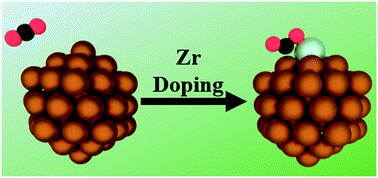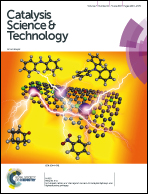CO2 activation on Cu-based Zr-decorated nanoparticles†
Abstract
Density functional theory (DFT) calculations have been applied to investigate the electronic and CO2 adsorption properties of 55-atom Cu-based nanoparticles (NPs) decorated with Zr atoms (Cu55−xZrx, x = 0–12). Our results revealed that the Zr atoms preferably reside on the surface of the Cu NPs generating sites that chemisorb and activate CO2 (linear to bent geometry and elongation of C![[double bond, length as m-dash]](https://www.rsc.org/images/entities/char_e001.gif) O bonds). Importantly, we demonstrate that while the CO2 formation of the activated state on the Cu NPs is endothermic, it becomes barrierless and exothermic on the Zr-decorated NPs. The CO2 activation and chemisorption was attributed to charge transferred from the NPs to the CO2 molecule. We identified the local-site d-band center and, interestingly, the ionization potential of the NP as descriptors correlating with the CO2 chemisorption. As a result, we demonstrate that one can tune the ionization potential of the NPs and, in turn the CO2 chemisorption energy, by varying the Zr content of the NPs. Additionally, we investigated the activity of CuZr NPs as catalysts for CO2 dissociation to CO and determined that Cu54Zr was a very efficient catalyst compared to Cu55. Overall, this work highlights how surface decoration can change the electronic properties of the NPs and result in CO2 activation, which are important steps for designing catalysts that capture and convert CO2 to fuels and chemicals.
O bonds). Importantly, we demonstrate that while the CO2 formation of the activated state on the Cu NPs is endothermic, it becomes barrierless and exothermic on the Zr-decorated NPs. The CO2 activation and chemisorption was attributed to charge transferred from the NPs to the CO2 molecule. We identified the local-site d-band center and, interestingly, the ionization potential of the NP as descriptors correlating with the CO2 chemisorption. As a result, we demonstrate that one can tune the ionization potential of the NPs and, in turn the CO2 chemisorption energy, by varying the Zr content of the NPs. Additionally, we investigated the activity of CuZr NPs as catalysts for CO2 dissociation to CO and determined that Cu54Zr was a very efficient catalyst compared to Cu55. Overall, this work highlights how surface decoration can change the electronic properties of the NPs and result in CO2 activation, which are important steps for designing catalysts that capture and convert CO2 to fuels and chemicals.



 Please wait while we load your content...
Please wait while we load your content...